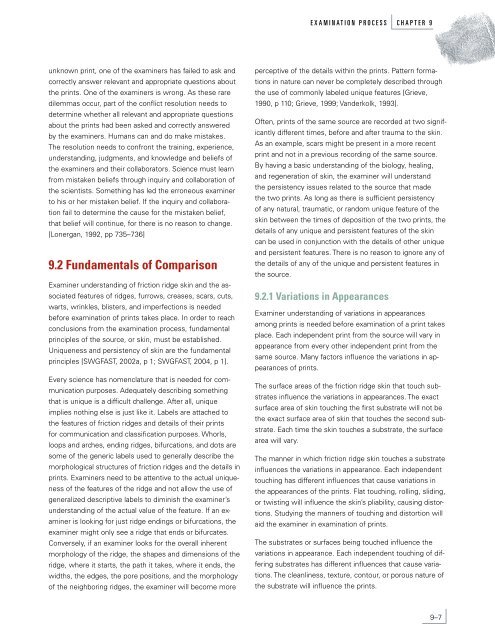John R. Vanderkolk - National Criminal Justice Reference Service
John R. Vanderkolk - National Criminal Justice Reference Service
John R. Vanderkolk - National Criminal Justice Reference Service
Create successful ePaper yourself
Turn your PDF publications into a flip-book with our unique Google optimized e-Paper software.
unknown print, one of the examiners has failed to ask and<br />
correctly answer relevant and appropriate questions about<br />
the prints. One of the examiners is wrong. As these rare<br />
dilemmas occur, part of the conflict resolution needs to<br />
determine whether all relevant and appropriate questions<br />
about the prints had been asked and correctly answered<br />
by the examiners. Humans can and do make mistakes.<br />
The resolution needs to confront the training, experience,<br />
understanding, judgments, and knowledge and beliefs of<br />
the examiners and their collaborators. Science must learn<br />
from mistaken beliefs through inquiry and collaboration of<br />
the scientists. Something has led the erroneous examiner<br />
to his or her mistaken belief. If the inquiry and collabora-<br />
tion fail to determine the cause for the mistaken belief,<br />
that belief will continue, for there is no reason to change.<br />
[Lonergan, 1992, pp 735–736]<br />
9.2 Fundamentals of Comparison<br />
Examiner understanding of friction ridge skin and the as-<br />
sociated features of ridges, furrows, creases, scars, cuts,<br />
warts, wrinkles, blisters, and imperfections is needed<br />
before examination of prints takes place. In order to reach<br />
conclusions from the examination process, fundamental<br />
principles of the source, or skin, must be established.<br />
Uniqueness and persistency of skin are the fundamental<br />
principles [SWGFAST, 2002a, p 1; SWGFAST, 2004, p 1].<br />
Every science has nomenclature that is needed for com-<br />
munication purposes. Adequately describing something<br />
that is unique is a difficult challenge. After all, unique<br />
implies nothing else is just like it. Labels are attached to<br />
the features of friction ridges and details of their prints<br />
for communication and classification purposes. Whorls,<br />
loops and arches, ending ridges, bifurcations, and dots are<br />
some of the generic labels used to generally describe the<br />
morphological structures of friction ridges and the details in<br />
prints. Examiners need to be attentive to the actual unique-<br />
ness of the features of the ridge and not allow the use of<br />
generalized descriptive labels to diminish the examiner’s<br />
understanding of the actual value of the feature. If an ex-<br />
aminer is looking for just ridge endings or bifurcations, the<br />
examiner might only see a ridge that ends or bifurcates.<br />
Conversely, if an examiner looks for the overall inherent<br />
morphology of the ridge, the shapes and dimensions of the<br />
ridge, where it starts, the path it takes, where it ends, the<br />
widths, the edges, the pore positions, and the morphology<br />
of the neighboring ridges, the examiner will become more<br />
perceptive of the details within the prints. Pattern forma-<br />
tions in nature can never be completely described through<br />
the use of commonly labeled unique features [Grieve,<br />
1990, p 110; Grieve, 1999; <strong>Vanderkolk</strong>, 1993].<br />
Often, prints of the same source are recorded at two signif-<br />
icantly different times, before and after trauma to the skin.<br />
As an example, scars might be present in a more recent<br />
print and not in a previous recording of the same source.<br />
By having a basic understanding of the biology, healing,<br />
and regeneration of skin, the examiner will understand<br />
the persistency issues related to the source that made<br />
the two prints. As long as there is sufficient persistency<br />
of any natural, traumatic, or random unique feature of the<br />
skin between the times of deposition of the two prints, the<br />
details of any unique and persistent features of the skin<br />
can be used in conjunction with the details of other unique<br />
and persistent features. There is no reason to ignore any of<br />
the details of any of the unique and persistent features in<br />
the source.<br />
9.2.1 Variations in Appearances<br />
Examiner understanding of variations in appearances<br />
among prints is needed before examination of a print takes<br />
place. Each independent print from the source will vary in<br />
appearance from every other independent print from the<br />
same source. Many factors influence the variations in ap-<br />
pearances of prints.<br />
The surface areas of the friction ridge skin that touch sub-<br />
strates influence the variations in appearances. The exact<br />
surface area of skin touching the first substrate will not be<br />
the exact surface area of skin that touches the second sub-<br />
strate. Each time the skin touches a substrate, the surface<br />
area will vary.<br />
E X A M I N A T I O N P R O C E S S C H A P T E R 9<br />
The manner in which friction ridge skin touches a substrate<br />
influences the variations in appearance. Each independent<br />
touching has different influences that cause variations in<br />
the appearances of the prints. Flat touching, rolling, sliding,<br />
or twisting will influence the skin’s pliability, causing distor-<br />
tions. Studying the manners of touching and distortion will<br />
aid the examiner in examination of prints.<br />
The substrates or surfaces being touched influence the<br />
variations in appearance. Each independent touching of dif-<br />
fering substrates has different influences that cause varia-<br />
tions. The cleanliness, texture, contour, or porous nature of<br />
the substrate will influence the prints.<br />
9–7

















